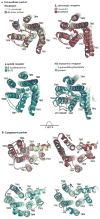Hitchhiking on the heptahelical highway: structure and function of 7TM receptor complexes
- PMID: 27093944
- PMCID: PMC5503103
- DOI: 10.1038/nrm.2016.36
Hitchhiking on the heptahelical highway: structure and function of 7TM receptor complexes
Abstract
A revolution in the analysis of seven transmembrane domain (7TM) receptors has provided detailed information about how these physiologically important signalling proteins interact with extracellular cues. However, it has proved much more challenging to understand how 7TM receptors convey information to their principal intracellular targets: heterotrimeric G proteins, G protein-coupled receptor kinases and arrestins. Recent structures now suggest a common mechanism that enables these structurally diverse cytoplasmic proteins to 'hitch a ride' on hundreds of different activated 7TM receptors in order to instigate physiological change.
Conflict of interest statement
The author declares no competing interests.
Figures



References
-
- Fredriksson R, Lagerstrom MC, Lundin LG, Schioth HB. The G-protein-coupled receptors in the human genome form five main families. Phylogenetic analysis, paralogon groups, and fingerprints. Mol Pharmacol. 2003;63:1256–72. - PubMed
-
- Bjarnadottir TK, et al. Comprehensive repertoire and phylogenetic analysis of the G protein-coupled receptors in human and mouse. Genomics. 2006;88:263–73. - PubMed
Publication types
MeSH terms
Substances
Grants and funding
LinkOut - more resources
Full Text Sources
Other Literature Sources

